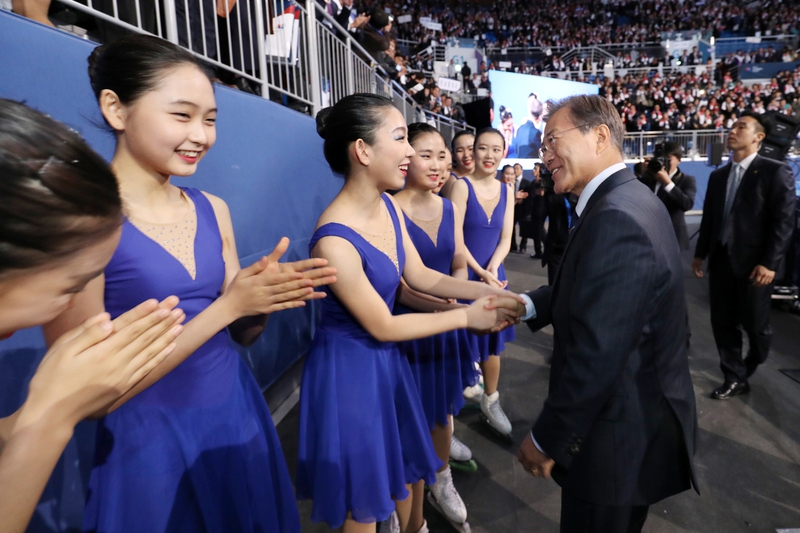 |
|
South Korean gold medalist Kim Yu-na, an honorary ambassador for the Pyeongchang Olympics, speaks to the UN General Assembly in support of the Olympic Truce resolution on Nov. 13. (AP/Yonhap News)
|
Foal Eagle and Key Resolve joint military drills may be postponed due to the measure
The Olympic Truce resolution was adopted in the UN General Assembly, calling for the cessation of all global conflict for the duration of the Pyeongchang Winter Olympics in Feb. 2018. Though it is a tradition to adopt the Olympic Truce before the summer and winter Olympics every two years, the high military tensions on the Korean Peninsula give this year’s truce particular significance. Attention is turning to South Korean President Moon Jae-in’s plan to take the truce as an opportunity to ease tensions on the Korean Peninsula and engineer a turning point in the North Korean nuclear crisis. The official title of the Olympic Truce that was passed during the 72nd session of the UN General Assembly in New York on the morning of Nov. 13 was “Building a peaceful and better world through sport and the Olympic ideal.” This resolution, which Moon submitted during a meeting with International Olympic Committee (IOC) President Thomas Bach in September, was largely drafted by the South Korean government and was co-sponsored by more than 140 countries, including the US, China, Japan and Russia. The main thrust of the resolution is the proposal to temporarily halt conflicts all over the world during the Pyeongchang Olympic Games (Feb. 9-25, 2018) and the Paralympic Winter Games (Mar. 9-18, 2018), with the truce starting seven days before the opening ceremony and ending seven days after the closing ceremony. This resolution does not have the legal force of a UN Security Council resolution, but by adopting the resolution, the UN is urging all member states to suspend hostilities from Feb. 2 to Mar. 25. The Olympic Truce, which traces back to the Ekecheiria (a truce held during the Olympics in ancient Greece), has been an Olympic tradition since it passed the UN General Assembly in Oct. 1993 and took force during the Lillehammer Winter Olympics the next year. Reflecting the special circumstances of the Korean Peninsula – namely, continuing concerns about a military clash – the Olympic Truce resolution calls for “safe passage, access and participation for athletes and relevant persons at the Games.” The resolution notes “that Pyeongchang 2018 marks the first of three consecutive Olympic and Paralympic Games to be held in Asia, to be followed by Tokyo 2020 and Beijing 2022, offering possibilities of new partnership in sport and beyond for Republic of Korea, Japan and China.” Speaking in support of the truce’s adoption was former South Korean figure skater and gold medalist Kim Yu-na. In a speech to the UN General Assembly, Kim, who is now serving as an honorary ambassador for the games, recalled the power of the Olympic spirit as she watched the opening ceremonies of the 2000 Summer Olympics in Sydney, Australia. With inter-Korean relations at a high point that summer, the North and South Korean Olympic delegations made a joint entrance to Stadium Australia. “The Olympic Charter states the goal of Olympism is to place sport at the service of the harmonious development of humankind with a view to promoting a peaceful society concerned with the preservation of human dignity,” she said. “Pyeonchang represents perhaps the most sincere effort to cross frozen borders between North and South Korea and foster a peaceful environment,” Kim added. The adoption of the Olympic Truce is being mentioned as a potential reason for adjusting the schedule or the scale of South Korea and the US’s Foal Eagle and Key Resolve joint military drills, which are held in February and March of every year. The South Korean government has reportedly looked into whether the suspension of North Korea’s nuclear weapons and missile activity and the reduction of the South Korea-US joint military exercises could be a starting point for dialogue on the North Korean nuclear issue. And since the Lunar New Year holiday (Feb. 15-18) and the 76th anniversary of the birth of Kim Jong-il (Feb. 16) happen to fall at the same time during the Olympic Truce, some are seeing this as an opportunity for arranging a reunion of families divided by the Korean War. But other factors are the possibility of North Korea carrying out an additional provocation before the Olympics and the state of North Korea-US relations. “North Korea responded with extreme sensitivity to the Seoul Olympics in 1988, which it regarded as an indicator of rivalry between the two governments. In order to stop that, we need to take a bold functional approach on issues such as reopening the Kaesong Complex and tourism to Mount Kumgang. Since North Korea at the moment has basically placed a moratorium on its nuclear weapons and missile programs, we need to be able to preemptively raise issues such as cancelling the South Korea-US joint military exercises,” said Koo Kab-woo, a professor at the University of North Korean Studies.
 |
|
President Moon Jae-in shakes hands with figure skaters following the close of their performance at the 18th conference of the National Unification Advisory Council at the Gangneung Ice Arena in Gangwon Province on Oct. 31. (Blue House Photo Pool)
|







